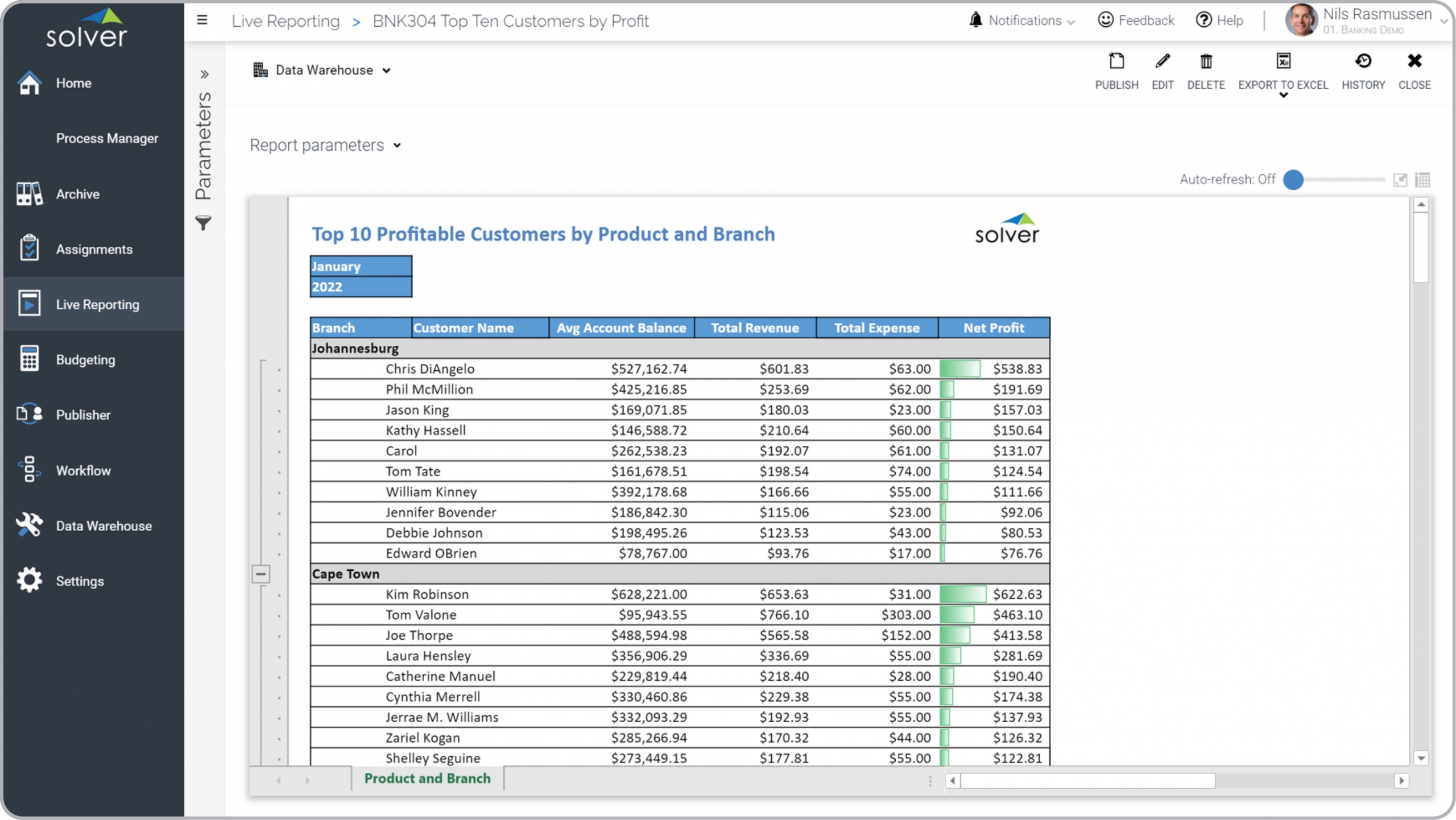Top Ten Customers by Profitability Report for Banks
What is
a
Top Ten Customers by Profitability Report for Banks
? Top Customer by Profitability Reports are considered customer ranking reports and are used by managers and account executives to get a snapshot of the top most profitable customer by branch. Some of the main functionality in this type of report is that it groups and ranks the top 10 customers by branch location. The columns include: Average account balance, Total revenue, Total expense, and Net profit. The color indicators help the user quickly see important metrics. You find an example of this type of report below.
Purpose of
Top Customers by Profitability Reports Banks use Top Customers by Profitability Reports to at any time be able to identify their most important customers at the branch level and overall. When used as part of good business practices in Executive- and Account Management departments, a bank can improve its customer retention strategies, and it can reduce the chances that top customers are not getting the optimal nurturing.
Example of a
Top Customers by Profitability Report Here is an example of a Top Ten Customer Report that ranks each customer based on profitability and groups them by branch. [caption id="" align="alignnone" width="2560"]
 Example of a Top Ten Customers by Profitability Report for banks[/caption] You can find hundreds of additional examples
here
Who Uses This Type of
Report
? The typical users of this type of report are: Account executives, production managers, branch managers, analysts.
Other Reports Often Used in Conjunction with
Top Customers by Profitability Reports Progressive Executive- and Account Management departments sometimes use several different Top Customers Reports, along with detailed customer transaction reports, financial statements, annual budgets, KPI dashboards, customer dashboards and other management and control tools.
Where Does the Data for Analysis Originate From? The Actual (historical transactions) data typically comes from bank systems and enterprise resource planning (ERP) systems like: Microsoft Dynamics 365 (D365) Finance, Microsoft Dynamics 365 Business Central (D365 BC), Microsoft Dynamics AX, Microsoft Dynamics NAV, Microsoft Dynamics GP, Microsoft Dynamics SL, Sage Intacct, Sage 100, Sage 300, Sage 500, Sage X3, SAP Business One, SAP ByDesign, Acumatica, Netsuite and others. In analyses where budgets or forecasts are used, the planning data most often originates from in-house Excel spreadsheet models or from professional corporate performance management (CPM/EPM) solutions.
What Tools are Typically used for Reporting, Planning and Dashboards? Examples of business software used with the data and ERPs mentioned above are:
Example of a Top Ten Customers by Profitability Report for banks[/caption] You can find hundreds of additional examples
here
Who Uses This Type of
Report
? The typical users of this type of report are: Account executives, production managers, branch managers, analysts.
Other Reports Often Used in Conjunction with
Top Customers by Profitability Reports Progressive Executive- and Account Management departments sometimes use several different Top Customers Reports, along with detailed customer transaction reports, financial statements, annual budgets, KPI dashboards, customer dashboards and other management and control tools.
Where Does the Data for Analysis Originate From? The Actual (historical transactions) data typically comes from bank systems and enterprise resource planning (ERP) systems like: Microsoft Dynamics 365 (D365) Finance, Microsoft Dynamics 365 Business Central (D365 BC), Microsoft Dynamics AX, Microsoft Dynamics NAV, Microsoft Dynamics GP, Microsoft Dynamics SL, Sage Intacct, Sage 100, Sage 300, Sage 500, Sage X3, SAP Business One, SAP ByDesign, Acumatica, Netsuite and others. In analyses where budgets or forecasts are used, the planning data most often originates from in-house Excel spreadsheet models or from professional corporate performance management (CPM/EPM) solutions.
What Tools are Typically used for Reporting, Planning and Dashboards? Examples of business software used with the data and ERPs mentioned above are:
- Native ERP report writers and query tools
- Spreadsheets (for example Microsoft Excel)
- Corporate Performance Management (CPM) tools (for example Solver)
- Dashboards (for example Microsoft Power BI and Tableau)
Corporate Performance Management (CPM) Cloud Solutions and More Examples
September 11, 2021
TAGS:
Reporting,
Solver,
report writer,
Microsoft,
template,
practice,
Acumatica,
customer,
Netsuite,
Finance,
planning,
GP,
fintech,
Business Central,
excel,
ax,
forecast,
Budget,
Dynamics 365,
budgeting,
bank,
Cloud,
Software,
Tableau,
SAP,
example,
best,
Sage,
BC,
D365,
NAV,
Intacct,
financial institution,
ranked,
CPM,
report,
branch,
SL,
Management,
dynamics,
Power BI,
Customer Profitability

